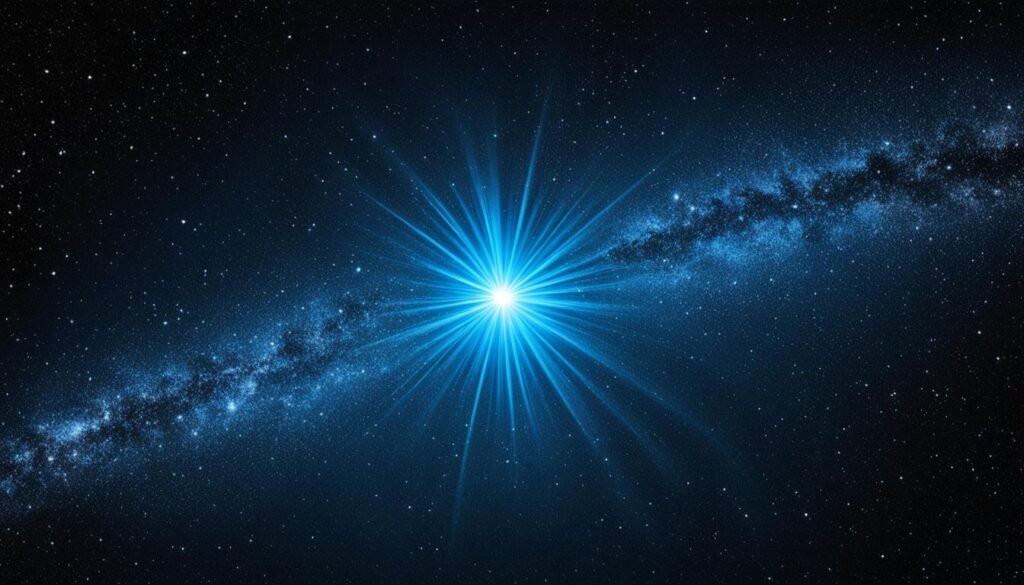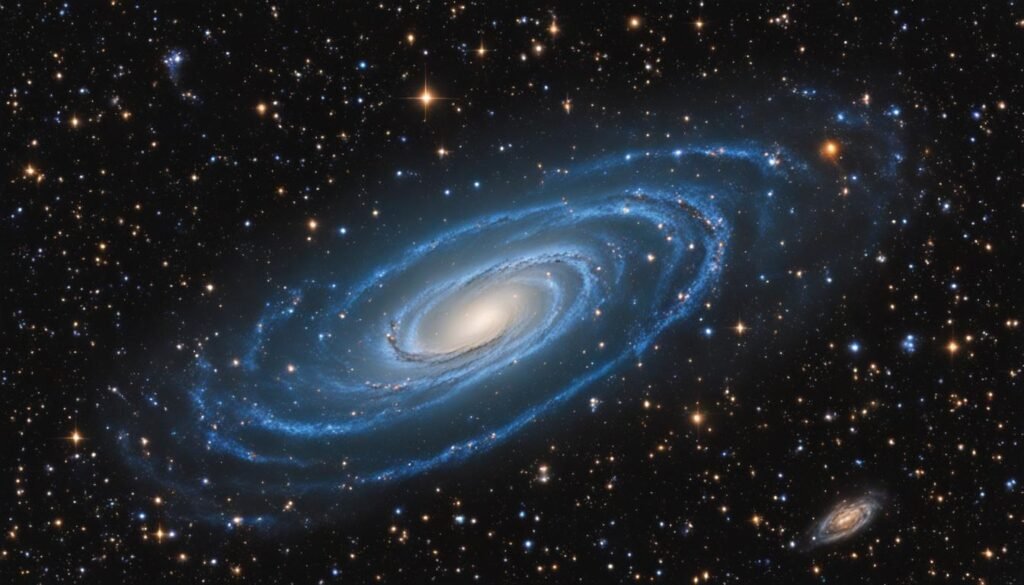| Genitive | |
| Abbreviation | |
| Pronunciation | |
| Main Stars | |
| Brightest Star | |
| Right Ascension | |
| Declination | |
| Sq. Deg. Area | |
| Crosses Meridian | |
| Visible Lat. Range |
Embark on a stellar journey as you explore the Indus constellation, a fascinating cluster of stars draped across the Indus night sky. Originally charted in the 16th century by renowned Dutch astronomer Petrus Plancius, this celestial ensemble has intrigued skywatchers for centuries. Dive into the depths of the southern hemisphere and uncover the secrets of this less luminous yet historically rich constellation. Your path through the heavens is intricately detailed within the Indus star map, officially sanctioned by the International Astronomical Union (IAU). While it may lack the flamboyance of brighter star clusters, Constellation Indus offers a unique vista into the cosmos. Join us as we traverse this starry terrain, whether you’re a seasoned astronomer or a curious novice eager to understand the domain where celestial navigation meets cultural legacy.
Within Constellation Indus, stars whisper tales of discovery, navigation, and the indelible marks of history. While wandering beneath the canvas of the night, your gaze will meet modest stars such as The Persian (Alpha Indi), a stalwart guide with an apparent magnitude of 3.11, and uncover celestial narratives enshrined by time and humanity. Let Constellation Indus be your gateway to the past as you seize the opportunity to navigate its splendors and savor the celestial majesty it keeps vigil in the nightscape.
Key Takeaways
- Indus constellation, while lacking in myth, is steeped in the annals of Dutch exploration.
- Its brightest star, The Persian (Alpha Indi), serves as a navigational guide with its recognizable glow.
- An Indus constellation guide can enhance your star-gazing experience and historical insight.
- The Indus star map, endorsed by the IAU, is essential for locating this southern celestial feature.
- Explore Indus constellation to witness a part of the sky less traveled but rich in astronomical and navigational heritage.
- Observing the Indus night sky may not dazzle with brilliance but will enrich with lineage and a touch of discovery.
- Constellation Indus is home to galaxies and stars with planets, extending an invitation to the wonders beyond our world.
Unveiling the History of Constellation Indus
Delving into the Constellation Indus history, you’ll uncover a narrative woven by celestial navigation and stellar curiosity. During the era of the great East Indies exploration, Dutch astronomers sketched the night sky with newfound star clusters, among them, the constellation of Indus. This southern sky tableau, laced with the story of its origin, reveals much about the connection between Earth’s explorers and the heavens.
Indus constellation origins trace back to the late 16th century through the influential work of Petrus Plancius. Born out of the Age of Discovery, Indus constellation creation is etched into the fabric of the universe, standing as both a celestial and cultural relic. In the manuscripts of celestial cartography, one could find the beguiling tableaux of the Indus star constellation, an ode to the era’s navigational prowess and the indigenous cultures encountered by explorers.
Origins and Nomenclature
The essence of the constellation Indus is encapsulated within its name. Derived from the Latin word for ‘the Indian’, Indus nomenclature recalls the visage of an indigenous man adept in archery. The constellation’s name, adopting the genitive form ‘Indi’, follows traditional astronomical naming conventions, assigning stars within its confines monikers that hark back to their celestial domicile.
The Dutch Legacy in the Stars
The constellation is an everlasting tribute to the Dutch astronomers who merged the acts of discovery and documentation. Among the remarkable feats that forged the modern celestial atlas was Pieter Dirkzoon Keyser’s notable astral contributions, making the Indus star cluster an intrinsic segment of the tapestry that scholars and adventurers alike would come to rely on for years to come.
Mythology and Cultural Depictions
While the Greek pantheon doesn’t spangle its story, Indus mythology is no less compelling. The Indus constellation meaning and cultural depictions of Indus revolve around its representation of a man with a bow, without the fabrications of deities or fantastical creatures. This divergence from mythological tradition underscores its inception in the modern world of astronomy.
The storied sky displays the Indus constellation’s figures with crisp clarity, making it a cornerstone of the cultural depictions of Indus. As your eyes glide across the cosmic tableau, remember the historical tapestry that the Indus star constellation weaves, a narrative born of terrestrial voyages and celestial mappings.
A look at the Indus star constellation need not be confined to historical ponderance. Its twinkling array is as much a part of the present as it is an echo of the past—a constellation meriting appreciation for its placement in history and its splendor in the night sky.
The Astronomical Map: Locating Constellation Indus
Embarking on a journey to find the Indus constellation takes you to the tranquil expanse of the fourth quadrant of the southern hemisphere (SQ4), a territory demarcated by latitudes +15° and -90°. Your night sky navigation adventure reveals the Indus constellation, an area untraveled by the ecliptic path of the sun, hence presenting a unique vantage point for stargazers. The astronomical map of Indus is rich with history, symbolizing the era of exploration that resonates through the southern celestial hemisphere.
The celestial tapestry weaves Indus among neighboring sky landmarks such as Grus, Telescopium, and Tucana, which not only enhance the stellar panorama but also serve as guideposts that locate the Indus constellation amid the vastness of the cosmos. These neighboring constellations provide key reference points that facilitate your quest to navigate and find Indus constellation with ease.
Below is a simple guide that will assist you to precisely pinpoint the Indus constellation’s location:
- Determine your position within the southern hemisphere—ideally between +15° and -90° latitude.
- Use a reliable astronomical map or a stargazing app which includes the SQ4 region.
- Look for the adjacent constellations – Grus, to the west, Telescopium to the north, and Tucana to the south.
- Scan the sky for a pattern resembling an Indian man holding an arrow, a modest-sized figure within the stars.
- Due to the sparse nature of bright stars in Indus, arm yourself with patience and allow your eyes to adapt to the darkness for optimal viewing.
Having the proper tools and guidance dramatically enhances your night sky navigation experience. Whether through high-tech apps or the traditional stargazing method with an astronomical map of Indus, the secrets of the cosmos await your discovery.
Stars of Indus: From Alpha to Epsilon
Embarking on a celestial journey through the Indus constellation, you will encounter a pantheon of stars, each with their unique characteristics and stories. At the constellation’s heart lies The Persian star, Alpha Indi, a beacon in the abyss, illuminating the astral backdrop with its considerable stellar magnitude. As you navigate through the Indus star map, the guiding lights of both ancient sailors and modern stargazers await.

The Persian – Alpha Indi, A Celestial Beacon
Alpha Indi, recognized as The Persian star and the brightest within the Indus constellation, grants us a glimpse into the universe’s vast expanse. With a discernable stellar magnitude, it allows for an awe-inspiring sight, visible even without the aid of a telescope. This K-type giant, approximately a billion years into its celestial voyage, has reached a mature phase in its stellar lifecycle, continuing to serve as an anchor point within Indus’s frame against the cosmos.
Epsilon Indi’s Significance and Proximity
Not far behind in importance is the Epsilon Indi star, lauded for its proximity to our solar system. Merely 11.83 light years from our planet, Epsilon Indi’s high proper motion captures the cosmic dance of celestial bodies. As an integral piece of constellation Indus astrology, Epsilon Indi is not only geographically significant but also resounds within the mythos of the constellation, symbolized as the arrow held in the Indian’s hand.
Navigational Stars within Indus
Throughout history, the stars of Indus have served as essential navigational assets. Among these, Beta Indi shines as a bright giant, with Theta Indi offering cosmic grace as a double star conveniently appreciated with modest telescopic power. Remarkably, Rho Indi is in the process of crafting its next evolutionary marvel, a planetary nebula, while T Indi provides a rhythmic light display, with its luminosity ebbing and flowing across an eleven-month period.
| Star Name | Type | Apparent Magnitude | Distance from Earth | Notable Features |
|---|---|---|---|---|
| Alpha Indi (The Persian star) | K-type Giant | 3.11 | 98.3 light years | Brightest star, visible without telescope |
| Epsilon Indi | Main Sequence K-type Dwarf | 4.69 | 11.83 light years | One of the closest stars to the solar system |
| Beta Indi | Bright Giant | 3.65 | Approximately 600 light years | Navigational star within Indus |
| Theta Indi | Double Star | 4.39 | 97 light years | Visible through a modest telescope |
| Rho Indi | Yellow Subgiant | 6.051 | – | Will eventually birth a planetary nebula |
| T Indi | Semi-Regular Variable Star | Variable | – | Periodic variability in brightness |
This astral ensemble, mapped out in the Indus zodiac, not only contributes profoundly to our understanding of the cosmos but also perpetuates the rich nautical legacy of the Indus navigational stars. They exemplify our perennial quest to not only locate ourselves within this vast universe but also to connect with the stories etched into the night sky. The stars of Indus beckon to your inquisitive spirit, inviting you to uncover the constellation’s brilliance with every clear night.
Notable Deep Sky Objects in the Constellation Indus Realm
Within the quiet stretches of the southern sky, the constellation Indus holds a treasure trove of celestial wonders. As a stargazer, your journey across this star cluster will reveal hidden gems and introduce you to galaxies far beyond our Milky Way. Let us embark on a captivating tour, analyzing deep sky features and unearthing the mysteries of deep sky objects in Indus.
Galaxies Galore: NGC and IC Designates
The celestial vault of Indus is rich with galactic tapestries woven by exquisite NGC galaxies in Indus and intriguing IC galaxies. These catalogs host the astral legacies of numerous Local Group member galaxies and serve as a lighthouse for deep space exploration. Your stargazing adventure through the Indus star cluster is bound to be replete with breathtaking vistas.
Exploring the Cosmic Features of NGC 7090
Emerging from the darkness is the strikingly structured NGC 7090 galaxy. An edge-on galaxy viewed sideways, its dusty spirals and active star-forming regions appear as cosmic calligraphy against the intergalactic canvas. With a telescope or a well-timed astrophotography session, you can witness the vibrant birthplaces of stars within this galaxy’s spiraling arms, adding a layer of awe to your stargazing NGC objects checklist.
IC 5152: A Celestial Wonder
Among Indus’ most fascinating residents is the IC 5152 irregular galaxy. Small and relatively nearby, this galaxy perplexes astronomers with its unclear status within the Local Group. Nevertheless, its sporadic stellar pattern and isolated brightness make it an essential object for anyone keen to analyze deep sky features, especially within the southern hemisphere’s celestial domains.
| Galaxy Name | Type | Approximate Distance | Notable Features |
|---|---|---|---|
| NGC 7090 | Spiral | 30 million light-years | Edge-on view, pink hydrogen clouds |
| IC 5152 | Irregular | Under debate | High resolution of stars, challenging foreground star |
As your night of stargazing NGC objects concludes, take pride in knowing that the cosmic wonders you’ve observed are but a fraction of the limitless expanse above. The NGC 7090 galaxy and the enigmatic IC 5152 irregular galaxy, nestled within the star-strewn field of Indus, remind us of the infinite journey of discovery that deep space exploration provides.

Stargazing Tips: Best Time and Location to View Constellation Indus
Embark on a celestial adventure by stargazing the Indus constellation, an extraordinary feature of the night sky rooted in astronomical history. When seeking the best time to view Indus, mark your calendars for September, particularly if you’re situated in the Southern Hemisphere. During this month, the constellation’s stars are poised for stunning visibility, transforming the night canvas into a mesmerizing stellar gallery. While observers at latitudes +15° and lower are privileged with a clearer glimpse, its absence from circumpolar regions promises a seasonal display that makes each sighting a special event.
Observing constellation Indus becomes an engaging endeavor as it graces the sky with a right ascension of 21 hours and sits 50 degrees south in declination. As Indus parades across the celestial sphere, its presence is transient but impactful, offering a modest illumination against the cosmic backdrop. To maximize your stargazing experience, consider using neighboring constellations as geographical guides. Their stellar configurations will lead your gaze to where Indus—a constellation without a flamboyant anchor star—dances quietly in the southern expanse.
To ensure optimal Indus constellation visibility, venture to a location with minimal light pollution, granting the ancient patterns of the skies the reverence they deserve. As you align your eyes and telescopes with the map of distant galaxies, embrace the tranquility of the celestial pursuit and reflect on the continuity of exploration, from the navigators of the seas to the modern-day stargazers reaching for an understanding of the universe. The best views of the constellation Indus await you, so prepare to capture the essence of the cosmos on a clear September night.
FAQ
What is the Indus Constellation and where is it located?
The Indus Constellation, symbolizing “the Indian,” is a constellation in the southern hemisphere introduced by Petrus Plancius in the 16th century. It’s located in the fourth quadrant of the southern hemisphere (SQ4), identifiable between latitudes +15° and -90°, and is best observed in September from the Southern Hemisphere.
Who discovered the Indus Constellation, and when?
Dutch astronomer Petrus Plancius first introduced Constellation Indus in the late 16th century, following observations by Dutch navigators such as Pieter Dirkzoon Keyser. It was later featured in Johann Bayer’s “Uranometria” star atlas in 1603.
Does the Indus Constellation have any connection to mythology?
Unlike many constellations tied to Greek myths, the Indus Constellation is not associated with any mythology. It depicts a cultural representation of a man with arrows, which likely reflects the natives encountered by Dutch explorers in regions such as Madagascar or the East Indies.
What are the brightest stars in the Indus Constellation?
The brightest star in the Indus Constellation is Alpha Indi, also known as The Persian, with an apparent magnitude of 3.11. Other notable stars include the Epsilon Indi, a nearby K-type dwarf with high proper motion, and Beta Indi, a bright giant.
Can you find deep sky objects within the Indus Constellation? Which are the most notable?
Yes, the Indus Constellation is home to several notable deep sky objects. These include NGC 7049, an odd hybrid galaxy, NGC 7090, an edge-on spiral galaxy with active star formation regions, and IC 5152, an irregular galaxy that might be part of the Local Group.
When is the best time to observe the Indus Constellation and how can one locate it?
The best time for stargazing the Indus Constellation is in September from the Southern Hemisphere. It can be found by locating its right ascension at 21 hours and its declination at 50 degrees South, with the aid of neighboring constellations like Grus, Telescopium, and Tucana.
Are there any meteor showers associated with the Indus Constellation?
The Indus Constellation is not known to be associated with any meteor showers, making it unique in that regard.
What is the Indus Constellation’s importance in astronomy?
While not the most prominent constellation, Indus is noteworthy for its historical significance from the era of Dutch exploration, its stars such as Epsilon Indi which are of interest due to their proximity and properties, and its galaxies that present opportunities for deep sky observation.
How does Indus’ lack of mythological connection affect its astrology?
Indus’ lack of mythological narratives means that it doesn’t hold the same astrological significance as other constellations with ancient myths. Its relatively recent addition to the night sky also suggests that it plays a less traditional role in astrology.
Is it possible to see the Indus Constellation from Northern Hemisphere locations?
The Indus Constellation is best seen from the Southern Hemisphere and is challenging to observe from Northern Hemisphere locations, where it remains low on the horizon and may not be visible at all beyond certain northern latitudes.






